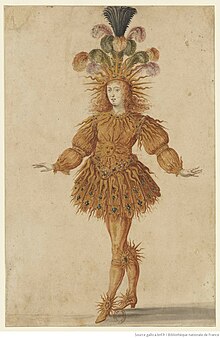Henri de Gissey

Henri (de) Gissey (ca 1621 – 1673) was a French draughtsman and designer who held the post of dessinateur de la Chambre et du cabinet de Roi in the Menus Plaisirs du Roi in the early years of Louis XIV of France. Jean Bérain the Elder, who succeeded him in the post, is likely to have been in some sense his pupil. Gissey's appointment made him responsible for the expressions of court style, above all in the elaborately costumed and produced ballets de cour, in which the young king danced among his courtiers; following Colbert's remodelling of the royal household, the Cabinet du Roi, to which Gissey was also attached, produced the sumptuous engraved festival books that often followed such events and are sometimes the only surviving record of them.
His court position demanded in addition to designs for costumes, designs for other kinds of court ceremonial festivities, carried out under the general direction of Louis Hesselin, "Overseer of the King's pleasures",[1] the part of the royal household— the Maison du Roi— in charge of entertainments. Hesselin was a grand collector, patron and amateur of art; for Hesselin's own lavish entertainments for the king, Gissey's office produced the costumes and sets. Several of his pen-and-wash designs for ballets de cour are at the Victoria and Albert Museum.[2] There are several designs for costumes for Louis XIV as Apollo, a role he repeated in numerous court ballets: several are at the Bibliothèque de l'Institut de France.[3] They are reminders of the extent to which the "Sun King" would identify himself as Apollo through consistent iconography at Versailles and in the sculptural program of its gardens and fountains.
Gissey seems to have worked as an engraver as well as a designer.[4]
Notes
[edit]- ^ Surintendant des plaisirs du Roi. A brief view of Hesselin is in J. H. Leopold and Clare Vincent, "A Watch for Monsieur Hesselin" Metropolitan Museum Journal 28 (1993), pp. 103–119.
- ^ Several illustrate Ian Woodfield, The Early History of the Viol (Cambridge University Press) 1984.
- ^ For Louis as Apollo in the Ballet de la Nuit, 1653 and in Les noces de Pélée et Thétis, 1654; illustrated in Fiona Garlick, "Dances to Evoke the King: The Majestic Genre Chez Louis XIV" Dance Research 15.2 (Winter 1997), pp. 10–34, figs 5 and 6. Another is in The Royal Collection, Windsor
- ^ Alexandre Pierre F. Robert-Dumesnil Le peintre-graveur français, ou Catalogue raisonné des estampes gravées par les peintres vol. 11, supplement (Paris) 1871 p. 108, notes two engravings by him, a Notre-Dame de Passay and a Crucifixion sold from the collection of M. R[obert] D[umesnil], Paris 11 March 1856.
Further reading
[edit]- Burden, Michael and Thorp, Jennifer. 2010. Le Ballet de la Nuit (Hillsdale, New York: Pendragon)
- Christout, Marie-Francoise. 1987. Le Ballet de Cour au XVIIe siecle. The Ballet de Cour in the 17th Century (Geneva: Minkoff) Author(s) of Review: Margaret McGowan, Dance Research: The Journal of the Society for Dance Research, Vol. 6, No. 1 (Spring, 1988), pp. 70–72
- En portugaise:
Montaiglon, Anatole de. Henri de Gissey de Paris: Desenhista Ordinário dos Divertimentos e dos Balés do Rei (1608–1675). Jundiaí, SP: Paco Editorial, 2012. ISBN 9788581481876
